with Edgeworthstown's historical Heritage & Literary Trail
Join a local guide on Edgeworthstown’s Heritage & Literary Trail. Explore a small country town in rural Ireland, quietly tucked away in Ireland’s Hidden Heartlands. And unearth its name: “The Town of the Great Writers”. Follow in the footsteps of historical figures, like Sir Walter Scott, William Wordsworth, Oscar Wilde and many more. Take one of our breathtaking literary walking tours and uncover their connections with the town of Edgeworthstown.
ONLINE BOOKING AVAILABLE FOR GROUPS OF 10+ PEOPLE.
Visit the charming grounds of Maria Edgeworth’s ancestral home
Abbé Edgeworth’s birthplace
Oliver Goldsmith’s residence during his school time
Oscar Wilde’s sister – Isola Wilde’s grave
Harry Clarke window
Maria Edgeworth Centre
You belong to a Walking Group or are planning, for example, an Active Age Event? We would love to tailor the tour to your needs! Just contact us and we plan your bespoke tour.
Besides, we also offer the option of a Self-guided Heritage & Literary Trail tour. Just come and collect a map and an Audio-Guide (€5) in our Maria Edgeworth Centre.
Edgeworthstown or Meathas Troim meaning “fertile Ridge” takes its name from the celebrated Edgeworth family who were settled here in 1619 from Edgeware in England.
Some prominent members of the family were:
Richard Lovell Edgeworth inventor, politician, educationalist and polymath. His daughter the novelist Maria Edgeworth (Castle Rackrent). His sons William, Lovell and Michael Pakenham Edgeworth. Also other members of the family included L’Abbé Edgeworth who attended to Louis XVI at his execution during the French Revolution. Francis Ysidro economist and Drummond Professor at Oxford University. Kenneth, engineer and noted astronomer, who has an asteroid named in his honour.
Additionally, the town also has close connections with many famous people including Oscar Wilde, whose sister Isola is buried here and celebrated nearby born poet Oliver Goldsmith.
The Maria Edgeworth Centre tells the story of Maria’s life and her works.
Visitors learn about the most celebrated English language novelist of the era, a contemporary of Jane Austen and Byron amongst others. Guided and supported by her father Richard Lovell Edgeworth, an inventor, surveyor and educator, she became one of the most successful authors of her time.
The Centre is part of the historical Edgeworthstown Heritage & Literary Trail. Nevertheless, it is open all year around and you can book a Tour just of the Centre to discover more about this amazing Family.



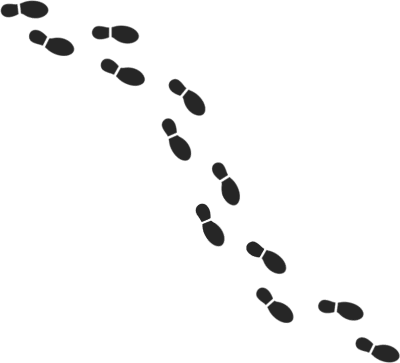
The present church was built on a site donated by Richard Lovell Edgeworth. It was designed by William Caldbeck and built in the Gothic style.
While building commenced in 1868, it only was dedicated in 1872. The church has an elaborate timber scissors truss roof structure, and beautifully designed stained glass windows, some designed by Harry Clarke. Furthermore, it boasts a beautiful, imposing silver sanctuary lamp.
All in all, a number of prominent clergy men are associated with the church, including Cardinal Cullen and the Rev. Dr. Peter Flood who later became the second president of St. Patrick’s College Maynooth.
Certainly the ancestral home of the Edgeworth’s. It dates from the late 18th century and is now a nursing home.
As early as 1619, Francis Edgeworth was granted some 600 acres of land near Mostrim by King James I. But it took another hundred years, before Francis’s great grandson Richard Edgeworth took over the estate and built Edgeworthstown House in the 1720’s.
The house was occupied by members of the family until 1935 when it was purchased by Mr. Bernard Noonan who donated the house and 50 acres to the Sisters of Mercy.
Not to mention, many historical figures including Sir Walter Scott, William Wordsworth, William Herschel and Sir William Rowan Hamilton visited the Edgeworth Family here. Not just a literary town, also a historical one!




In 1782 the Edgeworths found a formal garden beside their house. Later, in I827, a Philadelphia nursery-woman sent seeds of forty different plants – herbs, shrubs and trees – including Convolvulus and tiger lilies to Maria. After all, roses were among Maria Edgeworth’s favourite plants.
In addition, Michael Pakenham Edgeworth, Maria’s brother, began to send seeds from India to Ireland. A genus of flower ‘Edgeworthia’ is even named after Michael Pakenham Edgeworth.
Meanwhile, the Walled Garden has been restored and is again a fine example of the “Big House Garden”.
Another stop on Edgeworthstown’s Heritage & Literary Trail is the new ‘state of the art’ library.
Edgeworthstown, long a centre of literary creation, from Maria Edgeworth up to modern authors such as Vona Groarke and Belinda Mc Keown, was lacking in the provision of a suitable library.
Finally, this situation was rectified through the joint efforts of the Literary Society and the local authority, Longford County Council.
One of the unique elements of this project is the fact that the library is located on an historical site. On it stood once the school where Oliver Goldsmith received his early education. Furthermore, it was home to an experimental non-denominational school established by Lovell Edgeworth.


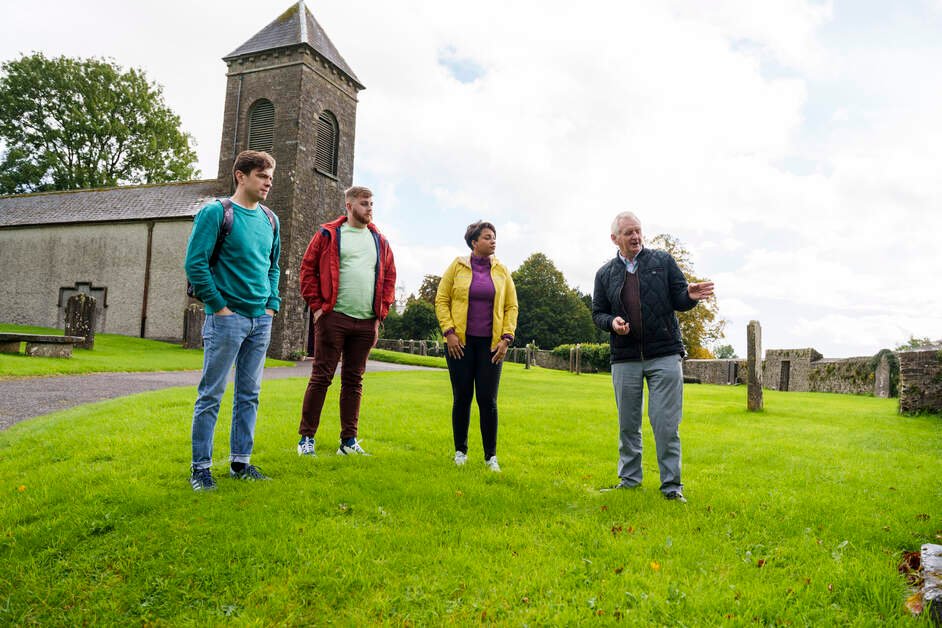
St. John’s Church was built in the early 1700’s on the site of an earlier Church. Then known as the “Church of the Edgeworths”. Later, Richard Lovell Edgeworth added a steel and slate spire to the church in 1811. Unfortunately, the spire was removed in 1935 for safety reasons.
Significantly, the church contains many memorials and plaques to members of the Edgeworth family, including one to Admiral Sir Francis Beaufort of the “Beaufort Wind Scale” fame.
The adjoining graveyard contains many fine headstones and table tombs and also includes the Edgeworth Family Vault where Maria and her father are interred.
Isola Wilde, sister to Oscar Wilde, and members of the O’Farrell clan are also interred here.

Edgeworthstown was known far and wide for its association with new ideas on education. Its most prominent figure Richard Lovell Edgeworth had personally sponsored a bill in the British Parliament some years earlier which had the stated purpose of setting up a public education system for poorer children in Ireland. An application for a school was submitted and the signatories to that application were Maria Edgeworth (the daughter of Richard Lovell, the world famous author and story teller) as well as C.J. Edgeworth, Esq. Thomas Gray PP and Laurence Reynolds. This was built on the Ballymahon Road oposite the Fair Green. There were to be two rooms 30ft x 20ft with the lower storey 12ft. high and the upper storey 10ft high. One early report on the school read ‘The mistress taught school for the last eighteen years in this town under the patronage of Miss Honoria Edgeworth of the Edgeworth family. The school has been opened for boys on Monday 26th April 1841 and for girls on Monday 3rd May 1841. The children learning the first elements pay 1d a week and children more advanced pay 2d a week’.
At the school examination on 3rd July 1855 there were 43 boys present out of an average enrolment of 132 with an average attendance of 54. In December 1891 the school closed in consequence of a serious illness and epidemic in the locality. A report in 1892 read “I certify that an epidemic of typhoid fever prevailed in this town and the neighbourhood during the last quarter of 1891 and the beginning of the present year. Signed – Joseph Langan, LRCSI, Edgeworthstown”.
Richard Hyland, who had been assistant since 1st January 1911 now became principal on the 9th July 1911. In 1911 the manager Canon Martin applied for grant towards the cost of enclosing the extension of the site and erecting outoffices.
In 1952 a grant of £3925 was sanctioned towards cost estimated at £4775 to erect a new school including cost of site, furniture etc., to accommodate 80 pupils in two rooms, each of 40 pupils. This school was built further out of town, also on the Ballymahon Road and eventually amalgamated with St. Elizabeth’s in 2001). With the opening of this school Richard Hyland retired on pension on 30th June 1953.
The hopes and dreams of many were realised when the Maria Edgeworth Centre opened in 2019. It was the culmination of many years of hard work by the society. The building has an historic past, it was one of the first schools built after the passing of the Education Act of 1831. This act, for the first time made provision for a government backed primary school system providing for the education of protestant and catholic children. Its building required the support of both religious communities and this school built in 1840 had Maria Edgeworth as one of its first patron. Incidentally, the contents of the act became, forty years later, the blueprint for a similar education system in England, Scotland and Wales which did not have a primary school system.
The Maria Edgeworth Centre interprets the live, times and works of Maria Edgeworth. She was a pioneer in the development of the modern day novel, she was also a pioneer in children’s literature , and a social commentator of the time. As a woman, she, under the law was not allowed to own landyet she managed the family estate on behalf of her brother Lovell after the death of their father. As well as interpreting their legacy the centre contains many books and artefacts associated with the family. It also houses the extensive Edgeworth Portrait Gallery and a permanent exhibition ‘Scenes from a Disembodied Past’ by artist Bernard Canavan, the exhibition depicts the story of forced emigration in the late 1550’s.
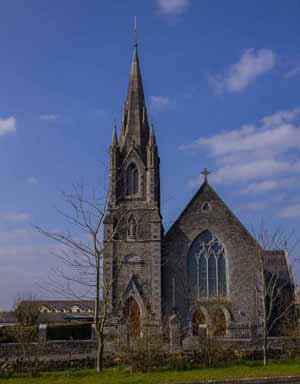
The present Church was built by Rev. Canon Peter Farrelly P.P. between 1868 and 1873. It was dedicated in 1873 by Cardinal Cullen and the sermon was given by the famous Dominican Fr. Tom Burke O.P. on the 24th of September 1873. Cardinal Cullen was in attendance at the invitation of his friend and former secretary Dr. Conroy bishop of Ardagh. The distinguished guests were later entertained in the Manor House. The title was originally “The Assumption of the Blessed Virgin Mary”. The architect of the church was Mr. Colbe and on his death Mr. Hague. The next parish priest Rev. Daniel Gray completed the building and erected the present parochial residence.
The final touches to the new church were carried out by his successor Canon Terence Martin who added the tower and steeple in 1909. The tower has a carved stone with the date A.D. 1872. The building is cruciform consisting of a porch as main entrance, nave, side aisles, sanctuary and a sacristy on either side. An earlier chapel stood between the present church and the grounds of the parochial house where the tombstone of its founder Fr. Thomas McCormick, who died in 1811, can still be seen. It was he who obtained the site from Richard Lovell Edgeworth and built the chapel in 1787. It succeeded a penal “Mass-house” where a strange accident was recorded in Faulkner’s Dublin Journal of 31st December 1749. It appears that during Mass some mischievous person outside cried “fire”. In the resulting confusion where people tried to get out, the wall gave way in several places and part of the roof fell in. One person was killed and 2 mortally bruised and upwards of 20 crushed and many severely hurt. The pulpit was also pitch pine and was a donation from the late Madame Edgeworth who was a catholic and died in Paris in 1928. She also gave a generous donation towards the erection of the tower and did not seek any publicity for her charity.
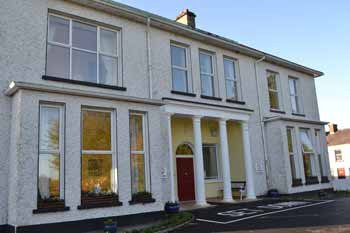
This historic house was originally built in 1672 by Richard Edgeworth. It had small windows, low wainscoted rooms and heavy cornices. The house was much enlarged and modernised after 1770 by Richard Lovell Edgeworth, the inventor and father of Maria Edgeworth.
The outside of the house originally had two storeys over the basement with two adjoining fronts with a prominent roof and detailed cornices. The entrance had a front of three bays between the triple windows in the upper storey and a doorway in a pillared recess between two shallow single-curved bows below.
In the Victorian period the right hand triple window was replaced by two windows and the right hand bow by a rectangular single storey projection. An adjoining front with three bay breakfront rises above the roofline as a pedimented attic. Richard Lovell Edgeworth inherited a ‘tolerably good old-fashioned mansion’ in 1782 and began to remodel it piecemeal almost as soon as he came into his estate. According to his daughter, the old house had been built on an inconvenient plan ‘for the sake of preserving one old chimney that had remained from the former edifice’. Its rooms were laid out in a row as a suite of apartments, which she disliked as they lacked the advantage of any passages; and all were small and gloomy, with heavy cornices, little windows and corner fireplaces.
The remodeling was ingenious if externally a little incoherent. Most of the new building was completed by 1787, when the Rev. Dr D.A. Beaufort visited the house and noted its unusual plan. On the ground floor Richard Lovell Edgeworth enlarged the rooms by throwing them into single storey, three bay rectangular projections linked in the middle by an arcaded loggia. There is a very nice curved tip lib staircase in the centre of the house. Certain alterations, including a pair of flat-roofed extensions to the ground-floor rooms on the South, built to provide an extra space for the library, and a matching conservatory which opened off Mrs Edgeworth’s dressing room, were not contrived until 1807, and it was only in 1812 that an oriel window was added to Maria’s bedroom in the North West corner of the house. This gave a few feet in space with great additional light and cheerfulness’, but was badly built and fell off well before the end of the century!
The Edgeworths’ entrance faced East. A five-bay, two-storey front with a central recessed porch of Ionic columns in antis, and light single-storey canted bay windows on either side. A shallow dentil cornice with a low blocking course was set before a hipped roof, rather too high to be fashionable at its later eighteenth century date. On the south side, the house is longer, of seven bays, with widely spaced windows except at the centre, where three bays are set close together and rise by an extra storey to an caves pediment. On the West side the rectangular architectural idiom is changed, for here the centre of the front is broken by a slightly projecting and shallow-curved central bay, which adopts the classic mid-Georgian, Irish country-house pattern of superimposed tripartite openings, a Venetian window, a tripartite window and a Diocletian window, set one above the other.
The novelties of Richard Lovell Edgeworth’s interior included some rooms with curved walls, particularly in the dining room in the centre of the South front, where a curved row of Scamozzian Ionic columns screened the N end of the room, and in the hall, which was originally oval. All of the new rooms had delicate understated cornices reminiscent of the taste of Thomas Cooley, though a room known as ‘the Cabinet’ and Mrs Edgeworth’s dressing room kept their old-fashioned heavy cornices and high keyhole grates of the 1750s. The buoyant sense of the adventure in life and the delight in clever contrivance make Edgeworth comparable to another architectural amateur and inventor at the turn of the century, Romas Jefferson, whose home at Monticello, Virginia, was hardly less ingenious.
Rising from undulating parkland, with specimen trees, shrub roses and winding paths about the house, Edgeworthstown was once perhaps the perfect embodiment in Ireland of the taste of Humphry Repton. Dr Beaufort noted its ‘unusual style of large windows with small piers’, which made it ‘very cheerful’.
Edgeworth’s many inventions included leather straps to prevent the spring doors from slamming; a central heating system whereby warm air was admitted into the room from above the chimney pieces; and a pump in the farmyard which carried water to the cisterns in the house and at the same time dispensed coins to beggars in return for a given time at the handle.
The house was inherited in 1876 by Mrs. C.F. Mantogue, whose mother was Edgeworth. It was sold to a Mr. Bernard Noonan together with 50 acres of land, who gave it to an order of Nuns and it is now used as a Nursing Home.
The interior has been gutted and rebuilt and the exterior has also been greatly changed. It is now a building with beautiful lawns surrounding it and is a source of pride to all of Edgeworthstown.

At Edgeworthstown in 1782 the Edgeworths found a formal garden that had ‘… been originally laid out in humble imitation, on a small scale, of the frontispiece to Millar’s Gardener’s Dictionary, in the original Dutch taste’.
Richard Lovell Edgeworth set about replanting this as a landscape garden, with trees ‘… planted in side scenes’. One of the people who gave Maria plants was John Foster of Collon, an old school-friend of her father. He was a leading member of the (Royal) Dublin Society and played a
signal role in the founding of that society’s botanical garden at Glasnevin, near Dublin. In I827, a Philadelphia nurserywoman sent seeds of forty different plants – herbs, shrubs and trees – including Convolvuluas and tiger lilies. Roses were among Maria Edgeworth’s favourite plants. Some came from an American correspondent, Professor Jackson, in 1846. Other roses came from Irish sources; damask roses, ‘everblowing’ roses, ‘Maiden’s Blush’, a ‘Giant rose, otherwise called a Swiss rose’, the yellow Scotch rose, ‘Knight’s new dark red everblowing’,
pompom roses, a blush burnet rose, and the ‘Rose des quatre saisons called by the common people the Quarter Session Rose.’ Michael Pakenham Edgeworth, Maria’s brother, began to send seeds from India to Ireland. In a letter to India, dated Io September I833, Maria reported that … Mr Mackay is very grateful for the seeds which you sent my mother and she judiciously sent him – He is now delighting himself with a tour of the north of Ireland & Scotland & he wrote me word that last week he found near Sligo some rare Alpine plants on a mountain called Ben Bulben’.The flowering shrub Buddleia was first grown in Edgeworthstown and a genus of flower Edgeworthia is named after Michael Pakenham Edgeworth.
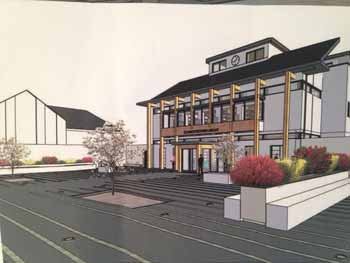
Work is due to end with the building of a new Library on the Main Street of the town. This is a story of endurance by the Society and members of the community.
Edgeworthstown, being the centre of literary creation since the 18th century from Goldsmith receiving his early education in the town, to the great Maria Edgeworth and more recently Vona Groarke and Belinda Mc Keown was lacking in the provision of a suitable library in the town. This situation was rectified through the joint efforts of the Society and the local authority Longford County Council. The Society provided the site and the local authority and the national government provided the finance.
One of the unique elements of this project is the fact the library is located on an historical site. It was once the site of a school where Oliver Goldsmith received his early education before going on to Trinity College Dublin, it was also the site of an experimental non-denominational school established by Lovell Edgeworth, brother to Maria. It was run based on the ideals of his father Richard Lovell Edgeworth.
The Library, alongside being a wonderful community resource, will house an extensive Edgeworth library and contain Edgeworth artefacts.
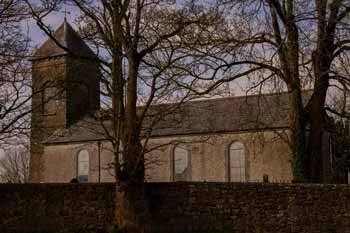
At Edgeworthstown in 1782 the Edgeworths found a formal garden that had ‘… been originally laid out in humble imitation, on a small scale, of the frontispiece to Millar’s Gardener’s Dictionary, in the original Dutch taste’.
The final touches to the new church were carried out by his successor Canon Terence Martin who added the tower and steeple in 1909. The tower has a carved stone with the date A.D. 1872. The building is cruciform consisting of a porch as main entrance, nave, side aisles, sanctuary and a sacristy on either side. An earlier chapel stood between the present church and the grounds of the parochial house where the tombstone of its founder Fr. Thomas McCormick, who died in 1811, can still be seen. It was he who obtained the site from Richard Lovell Edgeworth and built the chapel in 1787. It succeeded a penal “Mass-house” where a strange accident was recorded in Faulkner’s Dublin Journal of 31st December 1749. It appears that during Mass some mischievous person outside cried “fire”. In the resulting confusion where people tried to get out, the wall gave way in several places and part of the roof fell in. One person was killed and 2 mortally bruised and upwards of 20 crushed and many severely hurt. The pulpit was also pitch pine and was a donation from the late Madame Edgeworth who was a catholic and died in Paris in 1928. She also gave a generous donation towards the erection of the tower and did not seek any publicity for her charity.